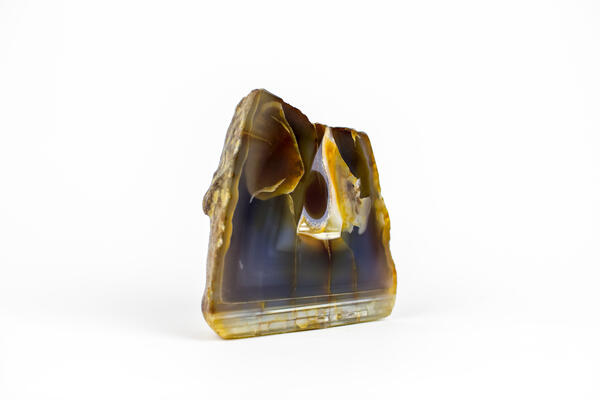Agate is a jewelry and ornamental stone with a layered texture, a type of chalcedony. According to one version, its name comes from the name of the Acate River on the island of Sicily (now it is called Dirillo), according to another version — from the ancient Greek word ‘akhates’, which means ‘happy’. In nature, agate exists in the form of geodes — this is the name of cavities in the rock filled with quartz crystals or inclusions of other minerals.
The composition of agate is silicon dioxide with a large number of impurities. Natural stone has a dull or matte shine, after processing its surface resembles glass. The color and pattern of this mineral can differ not only depending on the place of quarrying but even within the same geode. The number of layers forming multi-colored stripes can reach 600 per 1 millimeter.
Depending on the pattern and other external features, several varieties of agate are distinguished. Stones with a rainbow-colored surface are called iridescent; they are extremely rare and are not used in jewelry, because they are very difficult to process. Agates also include different types of chalcedony, which do not have a clear division into layers-strips, but the impurities form a specific pattern. For example, in moss agate, you can see the outlines of a forest or mountains, the pattern of a ruin agate resembles the ruins of an ancient castle, and a cloudy agate — the sky in the clouds.
In jewelry art, agate was used in ancient times. In Egypt, seals, vessels, and figurines were cut out of it, Roman artisans made patterned bowls and inserts for men and women’s jewelry. This stone was considered a charm against deception. Many believed that yellow agate could be a talisman for merchants and travelers, blue helped to draw inspiration for creative people, and red or pink brought luck in love.
During the Renaissance, powder boxes and snuffboxes with agate inserts became fashionable. At the same time, this stone was used to decorate the premises and garnish furniture with it. The masters not only used the material of natural colors but also painted it in other shades.
In modern industry, the so-called technical agate is used—a mineral of soft tones, which is not suitable for jewelry items or decorative art objects. It is used to make mortars for grinding various substances, prisms for precise chemical scales, parts of electric and water meters.
The composition of agate is silicon dioxide with a large number of impurities. Natural stone has a dull or matte shine, after processing its surface resembles glass. The color and pattern of this mineral can differ not only depending on the place of quarrying but even within the same geode. The number of layers forming multi-colored stripes can reach 600 per 1 millimeter.
Depending on the pattern and other external features, several varieties of agate are distinguished. Stones with a rainbow-colored surface are called iridescent; they are extremely rare and are not used in jewelry, because they are very difficult to process. Agates also include different types of chalcedony, which do not have a clear division into layers-strips, but the impurities form a specific pattern. For example, in moss agate, you can see the outlines of a forest or mountains, the pattern of a ruin agate resembles the ruins of an ancient castle, and a cloudy agate — the sky in the clouds.
In jewelry art, agate was used in ancient times. In Egypt, seals, vessels, and figurines were cut out of it, Roman artisans made patterned bowls and inserts for men and women’s jewelry. This stone was considered a charm against deception. Many believed that yellow agate could be a talisman for merchants and travelers, blue helped to draw inspiration for creative people, and red or pink brought luck in love.
During the Renaissance, powder boxes and snuffboxes with agate inserts became fashionable. At the same time, this stone was used to decorate the premises and garnish furniture with it. The masters not only used the material of natural colors but also painted it in other shades.
In modern industry, the so-called technical agate is used—a mineral of soft tones, which is not suitable for jewelry items or decorative art objects. It is used to make mortars for grinding various substances, prisms for precise chemical scales, parts of electric and water meters.


